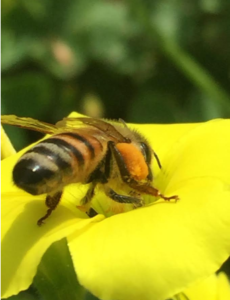*Bees are admirable little creatures, but they’re in terrible trouble. Nearly 7.6 billion procreating humans need them in order to survive. That means you.
Twenty thousand species of bees pollinate about 85 percent of flowering plants, or 336,000 species, including most of the 80,000 kinds of trees on Earth. In fact, bees help us breathe because without plants, we couldn’t exist!

Photo Credit: Dr. Reese Halter
Bees pollinate 75 percent of the world’s food crops and 100 percent of cotton, which clothes us. Bees account for as much as $577 billion in commerce per annum.
It’s not just the annual 2.2 billion pounds of honey, the backbone of many beverages, sauces, pastries and some bandages, that are astonishing. Bees produce medicines.
Bees make glue for their hives from tree resin, mixing it with enzymes in their mouths. This pungent bee glue is called propolis. Propolis contains antiviral, antifungal, anti-inflammatory, antibacterial and cancer-fighting compounds. Propolis is packed with strong secondary metabolites that scavenge the human body to rid it of free radicals, keeping us healthy.
Propovir is an Australian oral cream made from Canadian propolis. It quickly treats the Herpes simplex virus. Propovir knocks-out cold sores by effectively targeting all stages of the virus, from the initial prickle, or blister, through to healing full lesions.
Bees have brains at least 20,000 times smaller than humans. Their brains may be small in comparison but with approximately one million neurons (or the equivalent number of neurons in one human retina) they are amazing.
Bees are Nature’s smart superheroes.
Honeybees thirst for knowledge is similar to that of some humans.”
Bees, like humans, actively choose to focus their attention. That’s what the Queensland Brain Institute concluded when they implanted electrodes into the brains of bees, then tethered them so they couldn’t fly away. They then placed them on an air suspended ball, which they could steer by walking to control the movement of blinking lights on a screen.

Photo Credit: Dr. Reese Halter
Bees perform what is known as top-down learning. They are focused learners. Many animals are only capable of reacting to something external, like a bright light or noise. It’s referred to as bottom-up learning.
“The surprise now is what’s happening in their brains when they are doing these ‘smart things’. It’s quite similar to what’s happening with human brains,” remarked Dr. Bruno van Swinderen of the Queensland Brain Institute.
Honeybees and people also share genetic similarities. Some thrill seeking honeybees, just like people, are drawn to adventure. There are more than 1,000 genetic differences that affect a bee’s likelihood of being a thrill seeker.
Some honeybee brain neurons are responsible, according to Professor Gene Robinson of the University of Illinois, for giving distinct personalities.
Cambridge University workers and others discovered that bees could easily distinguish and recall different human faces. They surmised that it’s likely connected to the bees ability of recognizing different flowers.

Photo Credit: Dr. Reese Halter
In order to perform optimally, foragers require a restful night of sleep. Honeybees are able to store information in long-term memories while asleep. According to Dr. Walter Kaiser of the Institute of Zoology at Darmstadt Technical University, bees learn while they are asleep, just like humans do when we dream.
Kaiser’s work suggests that bees may dream, too!
Over the previous decade perhaps as many as a trillion honeybees have died. Widespread use of a couple billion pounds annually of a class of insecticides known as neonicotinoids, or neonics, has wreaked havoc with the bees around the globe.
It’s a neuro-active insecticide fashioned after nicotine. Neonics poison nerves and prevent the neurotransmitter acetylcholine from enabling neurons to communicate with each other and with muscle tissue.
By the way, in humans, acetylcholine is vital for memory, learning and rapid eye movement (REM) during sleep.
At two dozen parts per billion, neonics cause bees to lose their minds and shake to death, eerily similar to human symptoms of Alzheimer’s and Parkinson’s diseases.
Neonics are poisoning waterways in both Canada and the U.S.

Photo Credit: Dr. Reese Halter
Seventy-five percent of honey sampled from six continents were polluted with neonics. Neonics are in U.S. food, drinking water and even building supplies, including wood decking, polystyrene insulation, adhesive caulkings and plastic poly vinyl sidings.
Dutch toxicologist Dr. Henk Tenneke’s book, The Systemic Insecticides: A Disaster in the Making, concisely documented that neonics are water-soluble, mobile in soil and persistent for about a decade. Neonics kill soil organisms in turn robbing food from grassland birds. This causes avian predator populations to crash, too. No food, no birds.
It’s imperative that we respond now, North America is missing 1.5 billion birds.
Last month, European Union lawmakers banned all neonics from its fields. We require an immediate global ban on all neonics. They are accelerating the hideous Sixth Mass Extinction.
•••••••••••••••••••••••••••••••••••••••••••••
Dr Reese Halter is an award-winning broadcaster, distinguished conservation biologist and author.
Dr Reese Halter’s latest book is
Save Nature Now
Tweet @RelentlessReese
•••••••••••••••••••••••••••••••••••••••••••••












